Design Thinking Report: Opportunity, Discovery, Creativity, and Design
VerifiedAdded on 2019/11/12
|12
|2706
|604
Report
AI Summary
This report comprehensively examines design thinking, encompassing case study analysis, the design process, and the significance of creativity and innovation. It begins with an analysis of a case study, demonstrating how design thinking is applied to solve complex issues. The report then defines design innovation and creativity, outlining the five stages of the design process: empathize, problem definition, idea generation, prototype, and testing. It emphasizes the importance of design thinking in fostering innovation and implementing strategies effectively. The report includes a reflection on a creativity presentation, illustrating the practical application of design thinking principles within a business context. Overall, the report provides a detailed overview of design thinking, offering valuable insights for students and professionals seeking to enhance their problem-solving and innovation skills.
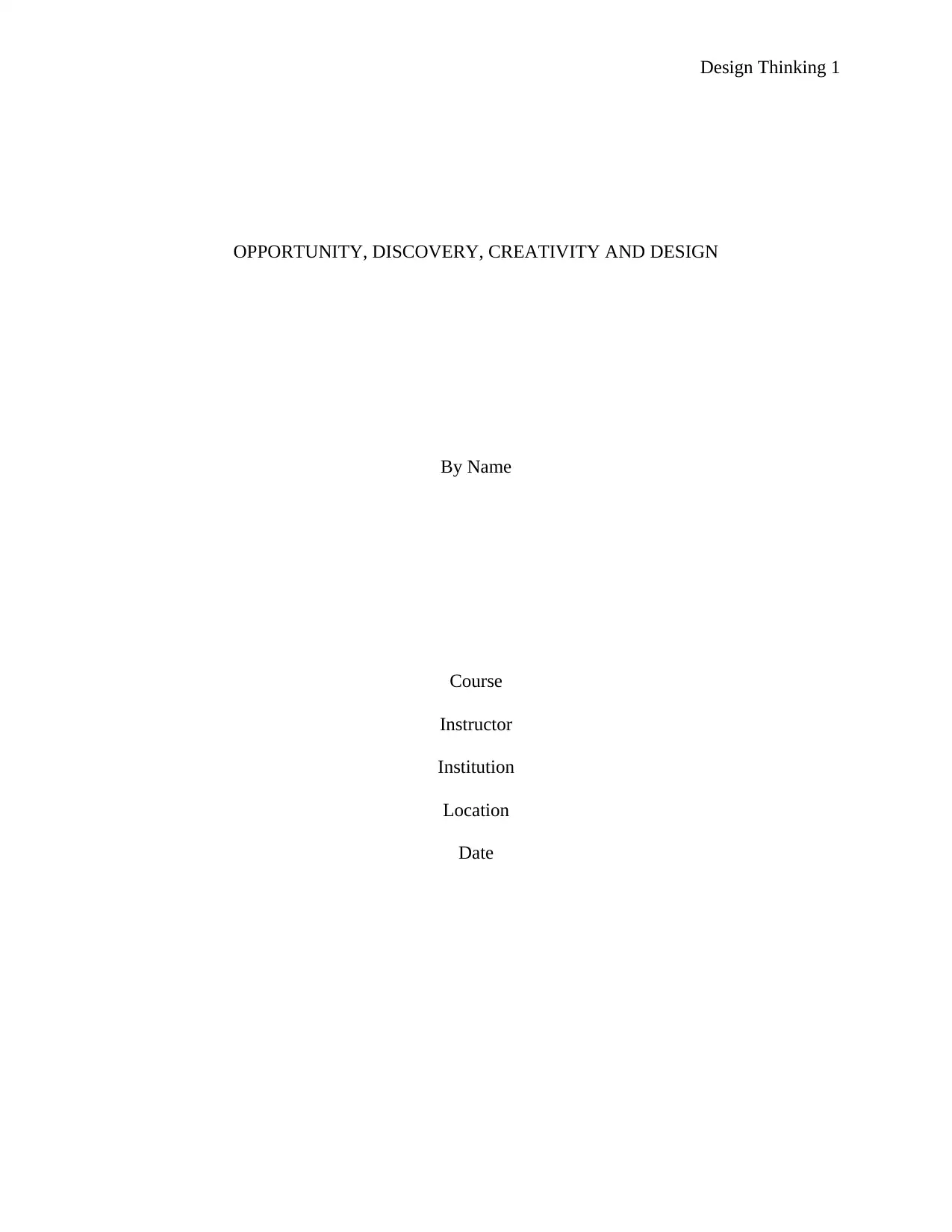
Design Thinking 1
OPPORTUNITY, DISCOVERY, CREATIVITY AND DESIGN
By Name
Course
Instructor
Institution
Location
Date
OPPORTUNITY, DISCOVERY, CREATIVITY AND DESIGN
By Name
Course
Instructor
Institution
Location
Date
Paraphrase This Document
Need a fresh take? Get an instant paraphrase of this document with our AI Paraphraser
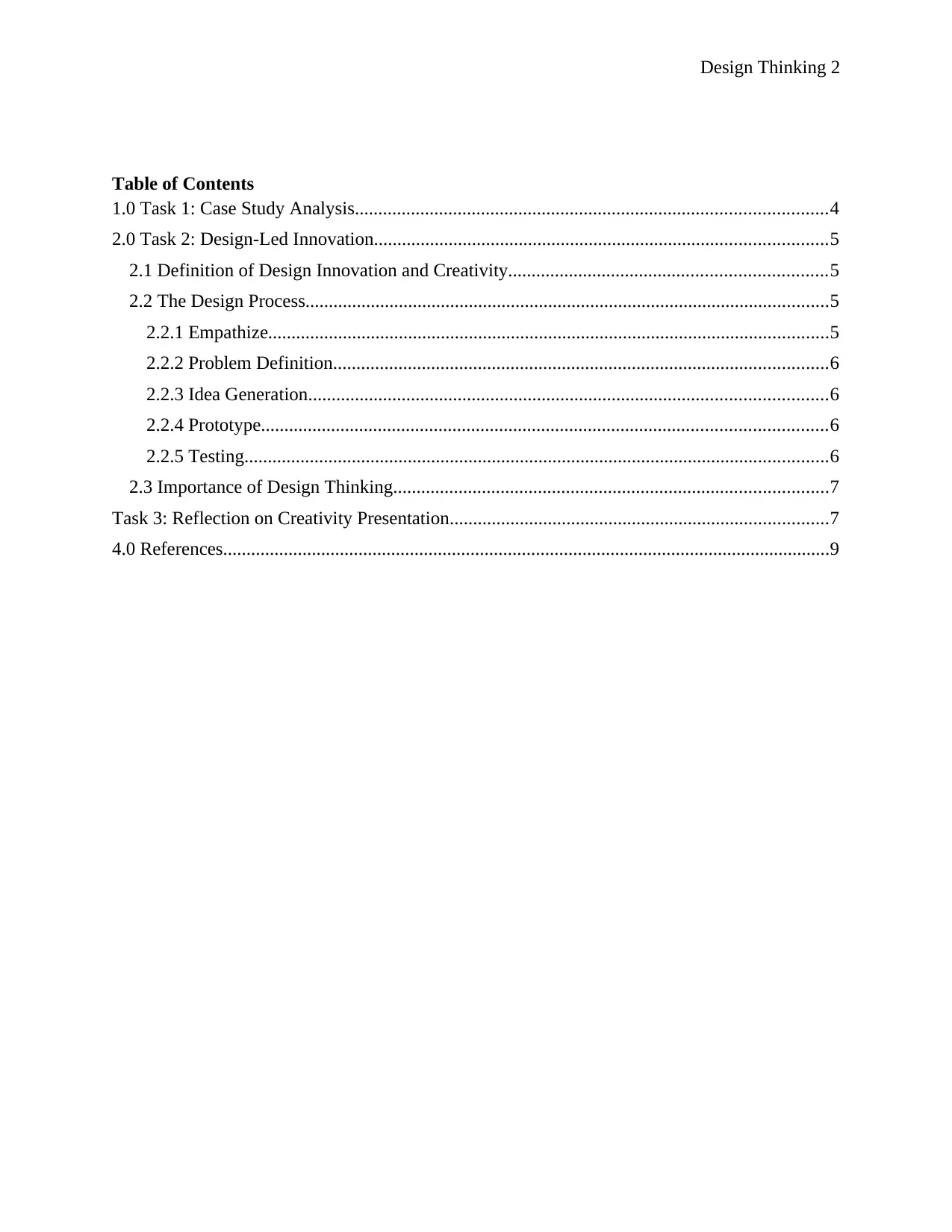
Design Thinking 2
Table of Contents
1.0 Task 1: Case Study Analysis.....................................................................................................4
2.0 Task 2: Design-Led Innovation.................................................................................................5
2.1 Definition of Design Innovation and Creativity....................................................................5
2.2 The Design Process................................................................................................................5
2.2.1 Empathize........................................................................................................................5
2.2.2 Problem Definition..........................................................................................................6
2.2.3 Idea Generation...............................................................................................................6
2.2.4 Prototype.........................................................................................................................6
2.2.5 Testing.............................................................................................................................6
2.3 Importance of Design Thinking.............................................................................................7
Task 3: Reflection on Creativity Presentation.................................................................................7
4.0 References..................................................................................................................................9
Table of Contents
1.0 Task 1: Case Study Analysis.....................................................................................................4
2.0 Task 2: Design-Led Innovation.................................................................................................5
2.1 Definition of Design Innovation and Creativity....................................................................5
2.2 The Design Process................................................................................................................5
2.2.1 Empathize........................................................................................................................5
2.2.2 Problem Definition..........................................................................................................6
2.2.3 Idea Generation...............................................................................................................6
2.2.4 Prototype.........................................................................................................................6
2.2.5 Testing.............................................................................................................................6
2.3 Importance of Design Thinking.............................................................................................7
Task 3: Reflection on Creativity Presentation.................................................................................7
4.0 References..................................................................................................................................9
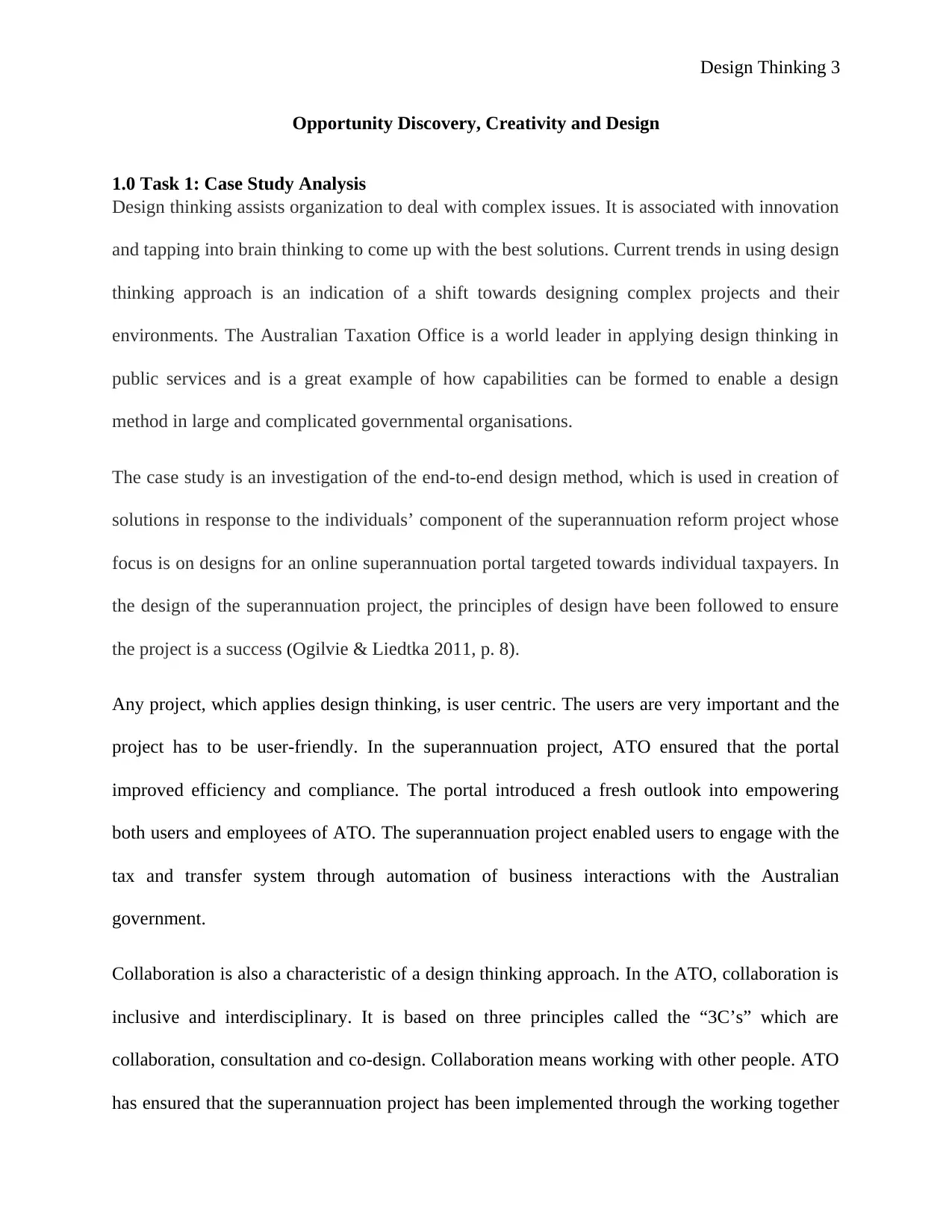
Design Thinking 3
Opportunity Discovery, Creativity and Design
1.0 Task 1: Case Study Analysis
Design thinking assists organization to deal with complex issues. It is associated with innovation
and tapping into brain thinking to come up with the best solutions. Current trends in using design
thinking approach is an indication of a shift towards designing complex projects and their
environments. The Australian Taxation Office is a world leader in applying design thinking in
public services and is a great example of how capabilities can be formed to enable a design
method in large and complicated governmental organisations.
The case study is an investigation of the end-to-end design method, which is used in creation of
solutions in response to the individuals’ component of the superannuation reform project whose
focus is on designs for an online superannuation portal targeted towards individual taxpayers. In
the design of the superannuation project, the principles of design have been followed to ensure
the project is a success (Ogilvie & Liedtka 2011, p. 8).
Any project, which applies design thinking, is user centric. The users are very important and the
project has to be user-friendly. In the superannuation project, ATO ensured that the portal
improved efficiency and compliance. The portal introduced a fresh outlook into empowering
both users and employees of ATO. The superannuation project enabled users to engage with the
tax and transfer system through automation of business interactions with the Australian
government.
Collaboration is also a characteristic of a design thinking approach. In the ATO, collaboration is
inclusive and interdisciplinary. It is based on three principles called the “3C’s” which are
collaboration, consultation and co-design. Collaboration means working with other people. ATO
has ensured that the superannuation project has been implemented through the working together
Opportunity Discovery, Creativity and Design
1.0 Task 1: Case Study Analysis
Design thinking assists organization to deal with complex issues. It is associated with innovation
and tapping into brain thinking to come up with the best solutions. Current trends in using design
thinking approach is an indication of a shift towards designing complex projects and their
environments. The Australian Taxation Office is a world leader in applying design thinking in
public services and is a great example of how capabilities can be formed to enable a design
method in large and complicated governmental organisations.
The case study is an investigation of the end-to-end design method, which is used in creation of
solutions in response to the individuals’ component of the superannuation reform project whose
focus is on designs for an online superannuation portal targeted towards individual taxpayers. In
the design of the superannuation project, the principles of design have been followed to ensure
the project is a success (Ogilvie & Liedtka 2011, p. 8).
Any project, which applies design thinking, is user centric. The users are very important and the
project has to be user-friendly. In the superannuation project, ATO ensured that the portal
improved efficiency and compliance. The portal introduced a fresh outlook into empowering
both users and employees of ATO. The superannuation project enabled users to engage with the
tax and transfer system through automation of business interactions with the Australian
government.
Collaboration is also a characteristic of a design thinking approach. In the ATO, collaboration is
inclusive and interdisciplinary. It is based on three principles called the “3C’s” which are
collaboration, consultation and co-design. Collaboration means working with other people. ATO
has ensured that the superannuation project has been implemented through the working together
⊘ This is a preview!⊘
Do you want full access?
Subscribe today to unlock all pages.

Trusted by 1+ million students worldwide
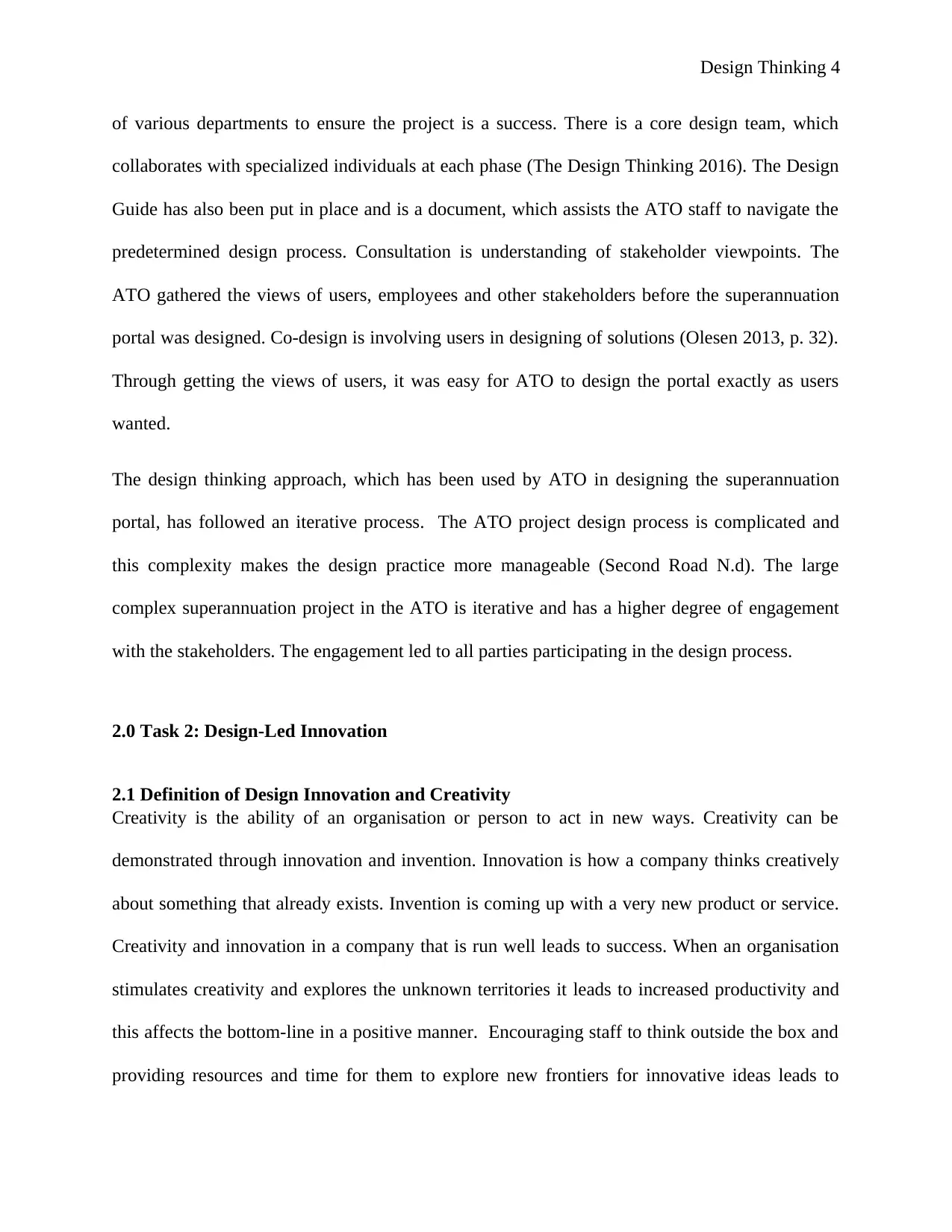
Design Thinking 4
of various departments to ensure the project is a success. There is a core design team, which
collaborates with specialized individuals at each phase (The Design Thinking 2016). The Design
Guide has also been put in place and is a document, which assists the ATO staff to navigate the
predetermined design process. Consultation is understanding of stakeholder viewpoints. The
ATO gathered the views of users, employees and other stakeholders before the superannuation
portal was designed. Co-design is involving users in designing of solutions (Olesen 2013, p. 32).
Through getting the views of users, it was easy for ATO to design the portal exactly as users
wanted.
The design thinking approach, which has been used by ATO in designing the superannuation
portal, has followed an iterative process. The ATO project design process is complicated and
this complexity makes the design practice more manageable (Second Road N.d). The large
complex superannuation project in the ATO is iterative and has a higher degree of engagement
with the stakeholders. The engagement led to all parties participating in the design process.
2.0 Task 2: Design-Led Innovation
2.1 Definition of Design Innovation and Creativity
Creativity is the ability of an organisation or person to act in new ways. Creativity can be
demonstrated through innovation and invention. Innovation is how a company thinks creatively
about something that already exists. Invention is coming up with a very new product or service.
Creativity and innovation in a company that is run well leads to success. When an organisation
stimulates creativity and explores the unknown territories it leads to increased productivity and
this affects the bottom-line in a positive manner. Encouraging staff to think outside the box and
providing resources and time for them to explore new frontiers for innovative ideas leads to
of various departments to ensure the project is a success. There is a core design team, which
collaborates with specialized individuals at each phase (The Design Thinking 2016). The Design
Guide has also been put in place and is a document, which assists the ATO staff to navigate the
predetermined design process. Consultation is understanding of stakeholder viewpoints. The
ATO gathered the views of users, employees and other stakeholders before the superannuation
portal was designed. Co-design is involving users in designing of solutions (Olesen 2013, p. 32).
Through getting the views of users, it was easy for ATO to design the portal exactly as users
wanted.
The design thinking approach, which has been used by ATO in designing the superannuation
portal, has followed an iterative process. The ATO project design process is complicated and
this complexity makes the design practice more manageable (Second Road N.d). The large
complex superannuation project in the ATO is iterative and has a higher degree of engagement
with the stakeholders. The engagement led to all parties participating in the design process.
2.0 Task 2: Design-Led Innovation
2.1 Definition of Design Innovation and Creativity
Creativity is the ability of an organisation or person to act in new ways. Creativity can be
demonstrated through innovation and invention. Innovation is how a company thinks creatively
about something that already exists. Invention is coming up with a very new product or service.
Creativity and innovation in a company that is run well leads to success. When an organisation
stimulates creativity and explores the unknown territories it leads to increased productivity and
this affects the bottom-line in a positive manner. Encouraging staff to think outside the box and
providing resources and time for them to explore new frontiers for innovative ideas leads to
Paraphrase This Document
Need a fresh take? Get an instant paraphrase of this document with our AI Paraphraser
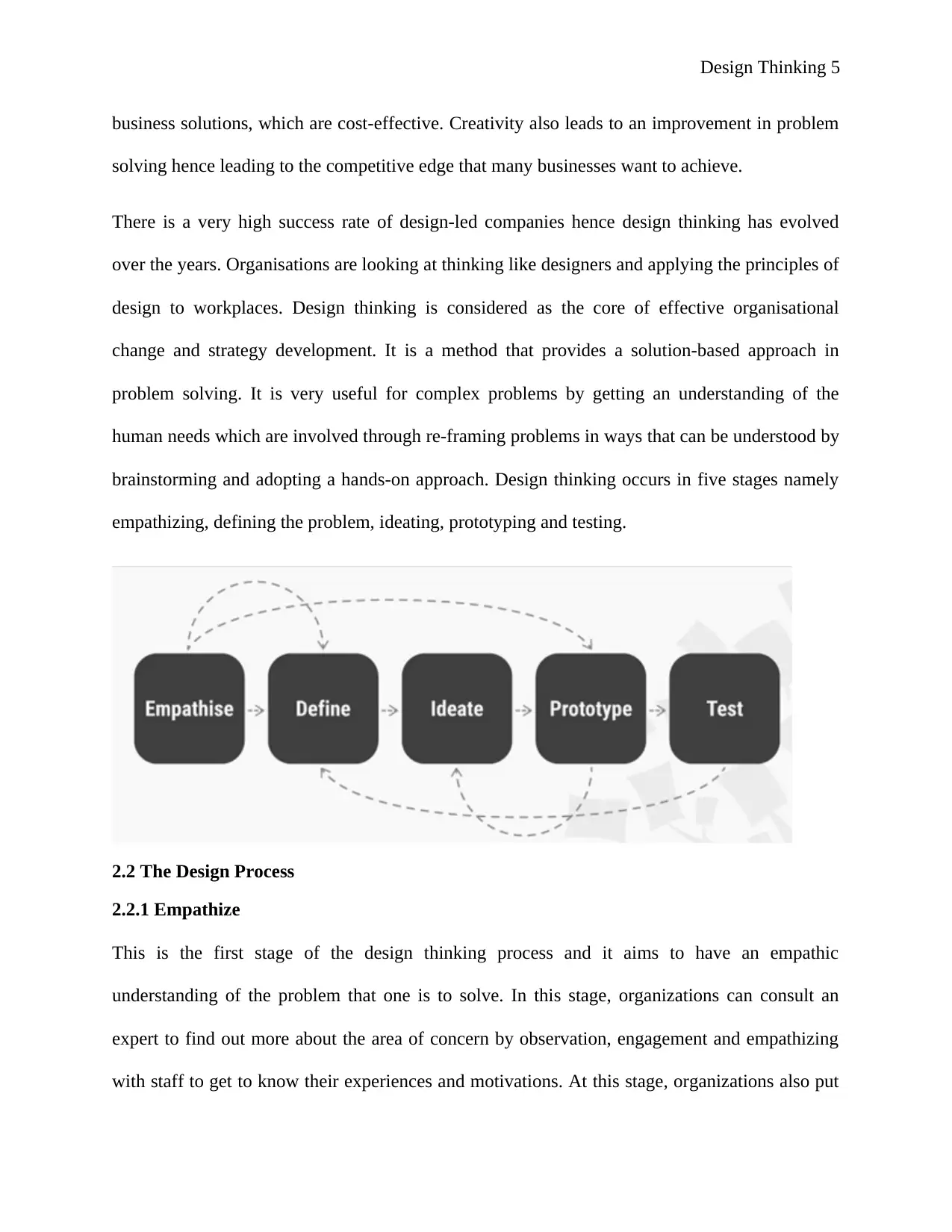
Design Thinking 5
business solutions, which are cost-effective. Creativity also leads to an improvement in problem
solving hence leading to the competitive edge that many businesses want to achieve.
There is a very high success rate of design-led companies hence design thinking has evolved
over the years. Organisations are looking at thinking like designers and applying the principles of
design to workplaces. Design thinking is considered as the core of effective organisational
change and strategy development. It is a method that provides a solution-based approach in
problem solving. It is very useful for complex problems by getting an understanding of the
human needs which are involved through re-framing problems in ways that can be understood by
brainstorming and adopting a hands-on approach. Design thinking occurs in five stages namely
empathizing, defining the problem, ideating, prototyping and testing.
2.2 The Design Process
2.2.1 Empathize
This is the first stage of the design thinking process and it aims to have an empathic
understanding of the problem that one is to solve. In this stage, organizations can consult an
expert to find out more about the area of concern by observation, engagement and empathizing
with staff to get to know their experiences and motivations. At this stage, organizations also put
business solutions, which are cost-effective. Creativity also leads to an improvement in problem
solving hence leading to the competitive edge that many businesses want to achieve.
There is a very high success rate of design-led companies hence design thinking has evolved
over the years. Organisations are looking at thinking like designers and applying the principles of
design to workplaces. Design thinking is considered as the core of effective organisational
change and strategy development. It is a method that provides a solution-based approach in
problem solving. It is very useful for complex problems by getting an understanding of the
human needs which are involved through re-framing problems in ways that can be understood by
brainstorming and adopting a hands-on approach. Design thinking occurs in five stages namely
empathizing, defining the problem, ideating, prototyping and testing.
2.2 The Design Process
2.2.1 Empathize
This is the first stage of the design thinking process and it aims to have an empathic
understanding of the problem that one is to solve. In this stage, organizations can consult an
expert to find out more about the area of concern by observation, engagement and empathizing
with staff to get to know their experiences and motivations. At this stage, organizations also put
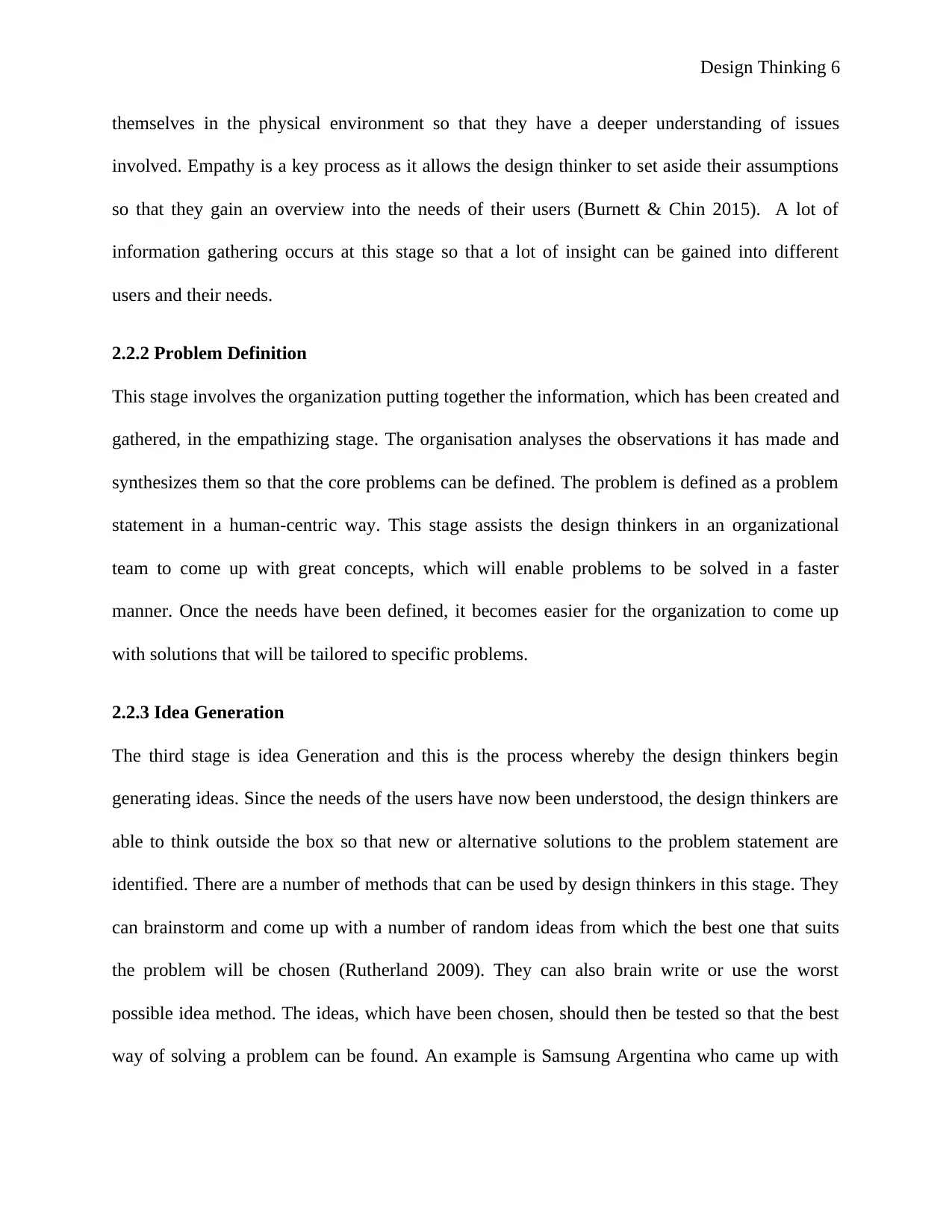
Design Thinking 6
themselves in the physical environment so that they have a deeper understanding of issues
involved. Empathy is a key process as it allows the design thinker to set aside their assumptions
so that they gain an overview into the needs of their users (Burnett & Chin 2015). A lot of
information gathering occurs at this stage so that a lot of insight can be gained into different
users and their needs.
2.2.2 Problem Definition
This stage involves the organization putting together the information, which has been created and
gathered, in the empathizing stage. The organisation analyses the observations it has made and
synthesizes them so that the core problems can be defined. The problem is defined as a problem
statement in a human-centric way. This stage assists the design thinkers in an organizational
team to come up with great concepts, which will enable problems to be solved in a faster
manner. Once the needs have been defined, it becomes easier for the organization to come up
with solutions that will be tailored to specific problems.
2.2.3 Idea Generation
The third stage is idea Generation and this is the process whereby the design thinkers begin
generating ideas. Since the needs of the users have now been understood, the design thinkers are
able to think outside the box so that new or alternative solutions to the problem statement are
identified. There are a number of methods that can be used by design thinkers in this stage. They
can brainstorm and come up with a number of random ideas from which the best one that suits
the problem will be chosen (Rutherland 2009). They can also brain write or use the worst
possible idea method. The ideas, which have been chosen, should then be tested so that the best
way of solving a problem can be found. An example is Samsung Argentina who came up with
themselves in the physical environment so that they have a deeper understanding of issues
involved. Empathy is a key process as it allows the design thinker to set aside their assumptions
so that they gain an overview into the needs of their users (Burnett & Chin 2015). A lot of
information gathering occurs at this stage so that a lot of insight can be gained into different
users and their needs.
2.2.2 Problem Definition
This stage involves the organization putting together the information, which has been created and
gathered, in the empathizing stage. The organisation analyses the observations it has made and
synthesizes them so that the core problems can be defined. The problem is defined as a problem
statement in a human-centric way. This stage assists the design thinkers in an organizational
team to come up with great concepts, which will enable problems to be solved in a faster
manner. Once the needs have been defined, it becomes easier for the organization to come up
with solutions that will be tailored to specific problems.
2.2.3 Idea Generation
The third stage is idea Generation and this is the process whereby the design thinkers begin
generating ideas. Since the needs of the users have now been understood, the design thinkers are
able to think outside the box so that new or alternative solutions to the problem statement are
identified. There are a number of methods that can be used by design thinkers in this stage. They
can brainstorm and come up with a number of random ideas from which the best one that suits
the problem will be chosen (Rutherland 2009). They can also brain write or use the worst
possible idea method. The ideas, which have been chosen, should then be tested so that the best
way of solving a problem can be found. An example is Samsung Argentina who came up with
⊘ This is a preview!⊘
Do you want full access?
Subscribe today to unlock all pages.

Trusted by 1+ million students worldwide
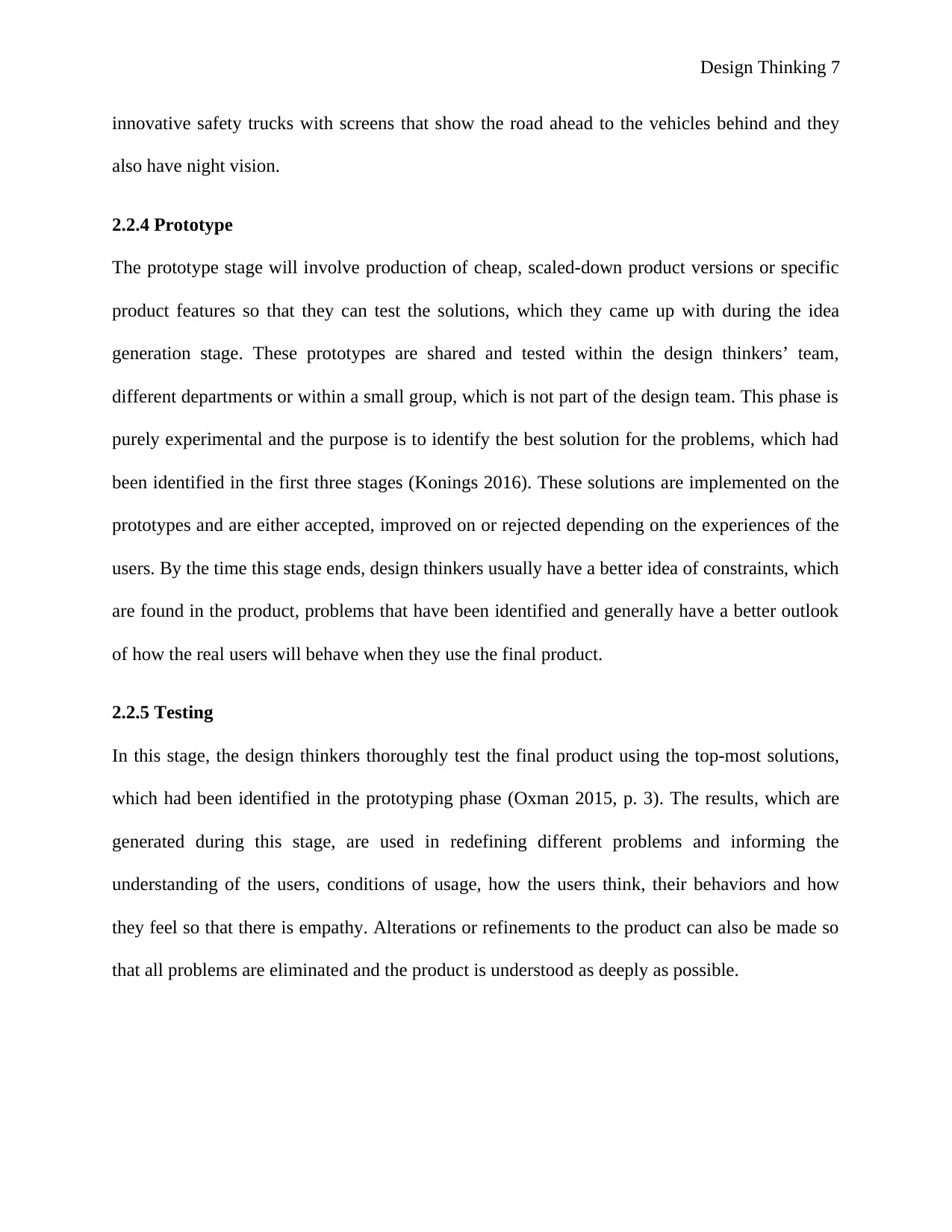
Design Thinking 7
innovative safety trucks with screens that show the road ahead to the vehicles behind and they
also have night vision.
2.2.4 Prototype
The prototype stage will involve production of cheap, scaled-down product versions or specific
product features so that they can test the solutions, which they came up with during the idea
generation stage. These prototypes are shared and tested within the design thinkers’ team,
different departments or within a small group, which is not part of the design team. This phase is
purely experimental and the purpose is to identify the best solution for the problems, which had
been identified in the first three stages (Konings 2016). These solutions are implemented on the
prototypes and are either accepted, improved on or rejected depending on the experiences of the
users. By the time this stage ends, design thinkers usually have a better idea of constraints, which
are found in the product, problems that have been identified and generally have a better outlook
of how the real users will behave when they use the final product.
2.2.5 Testing
In this stage, the design thinkers thoroughly test the final product using the top-most solutions,
which had been identified in the prototyping phase (Oxman 2015, p. 3). The results, which are
generated during this stage, are used in redefining different problems and informing the
understanding of the users, conditions of usage, how the users think, their behaviors and how
they feel so that there is empathy. Alterations or refinements to the product can also be made so
that all problems are eliminated and the product is understood as deeply as possible.
innovative safety trucks with screens that show the road ahead to the vehicles behind and they
also have night vision.
2.2.4 Prototype
The prototype stage will involve production of cheap, scaled-down product versions or specific
product features so that they can test the solutions, which they came up with during the idea
generation stage. These prototypes are shared and tested within the design thinkers’ team,
different departments or within a small group, which is not part of the design team. This phase is
purely experimental and the purpose is to identify the best solution for the problems, which had
been identified in the first three stages (Konings 2016). These solutions are implemented on the
prototypes and are either accepted, improved on or rejected depending on the experiences of the
users. By the time this stage ends, design thinkers usually have a better idea of constraints, which
are found in the product, problems that have been identified and generally have a better outlook
of how the real users will behave when they use the final product.
2.2.5 Testing
In this stage, the design thinkers thoroughly test the final product using the top-most solutions,
which had been identified in the prototyping phase (Oxman 2015, p. 3). The results, which are
generated during this stage, are used in redefining different problems and informing the
understanding of the users, conditions of usage, how the users think, their behaviors and how
they feel so that there is empathy. Alterations or refinements to the product can also be made so
that all problems are eliminated and the product is understood as deeply as possible.
Paraphrase This Document
Need a fresh take? Get an instant paraphrase of this document with our AI Paraphraser
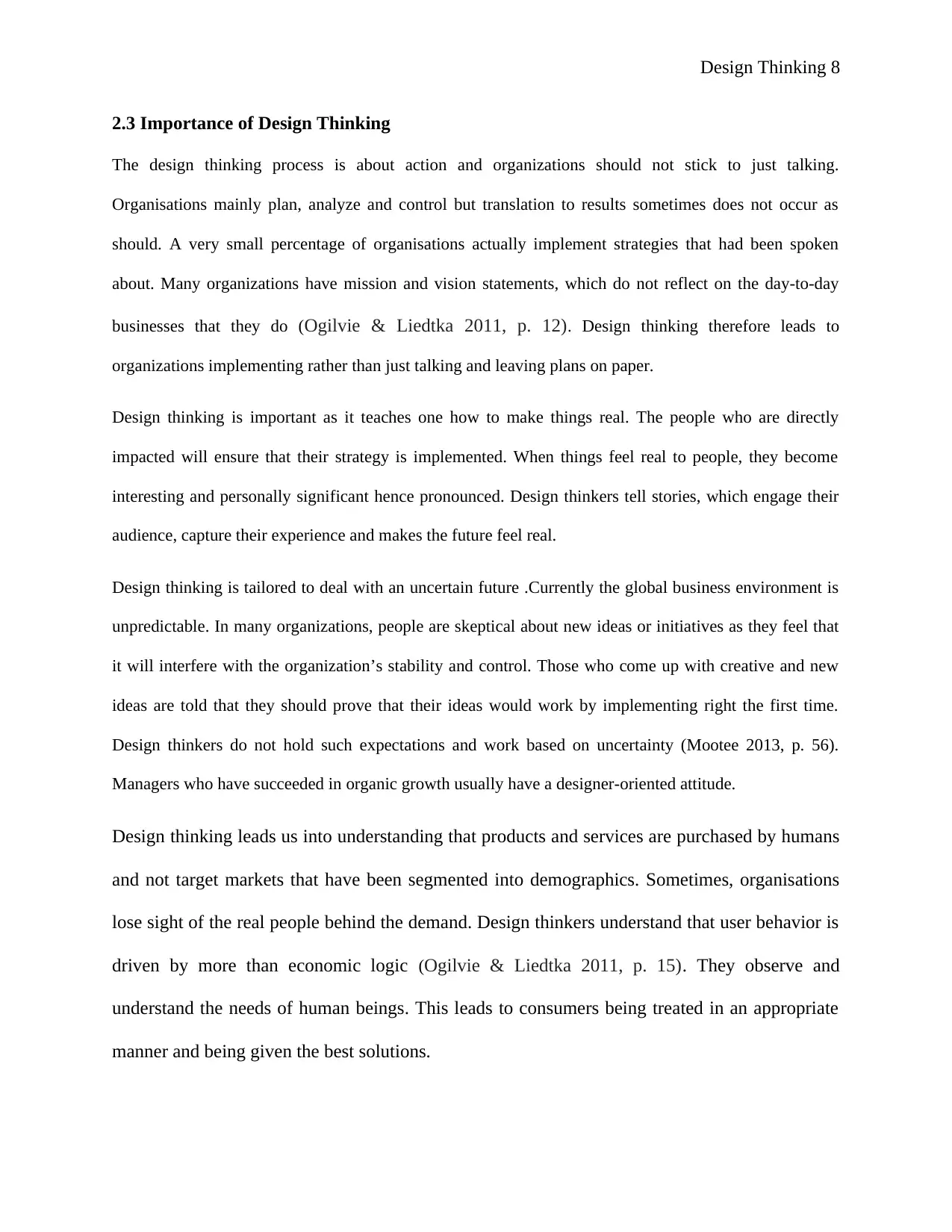
Design Thinking 8
2.3 Importance of Design Thinking
The design thinking process is about action and organizations should not stick to just talking.
Organisations mainly plan, analyze and control but translation to results sometimes does not occur as
should. A very small percentage of organisations actually implement strategies that had been spoken
about. Many organizations have mission and vision statements, which do not reflect on the day-to-day
businesses that they do (Ogilvie & Liedtka 2011, p. 12). Design thinking therefore leads to
organizations implementing rather than just talking and leaving plans on paper.
Design thinking is important as it teaches one how to make things real. The people who are directly
impacted will ensure that their strategy is implemented. When things feel real to people, they become
interesting and personally significant hence pronounced. Design thinkers tell stories, which engage their
audience, capture their experience and makes the future feel real.
Design thinking is tailored to deal with an uncertain future .Currently the global business environment is
unpredictable. In many organizations, people are skeptical about new ideas or initiatives as they feel that
it will interfere with the organization’s stability and control. Those who come up with creative and new
ideas are told that they should prove that their ideas would work by implementing right the first time.
Design thinkers do not hold such expectations and work based on uncertainty (Mootee 2013, p. 56).
Managers who have succeeded in organic growth usually have a designer-oriented attitude.
Design thinking leads us into understanding that products and services are purchased by humans
and not target markets that have been segmented into demographics. Sometimes, organisations
lose sight of the real people behind the demand. Design thinkers understand that user behavior is
driven by more than economic logic (Ogilvie & Liedtka 2011, p. 15). They observe and
understand the needs of human beings. This leads to consumers being treated in an appropriate
manner and being given the best solutions.
2.3 Importance of Design Thinking
The design thinking process is about action and organizations should not stick to just talking.
Organisations mainly plan, analyze and control but translation to results sometimes does not occur as
should. A very small percentage of organisations actually implement strategies that had been spoken
about. Many organizations have mission and vision statements, which do not reflect on the day-to-day
businesses that they do (Ogilvie & Liedtka 2011, p. 12). Design thinking therefore leads to
organizations implementing rather than just talking and leaving plans on paper.
Design thinking is important as it teaches one how to make things real. The people who are directly
impacted will ensure that their strategy is implemented. When things feel real to people, they become
interesting and personally significant hence pronounced. Design thinkers tell stories, which engage their
audience, capture their experience and makes the future feel real.
Design thinking is tailored to deal with an uncertain future .Currently the global business environment is
unpredictable. In many organizations, people are skeptical about new ideas or initiatives as they feel that
it will interfere with the organization’s stability and control. Those who come up with creative and new
ideas are told that they should prove that their ideas would work by implementing right the first time.
Design thinkers do not hold such expectations and work based on uncertainty (Mootee 2013, p. 56).
Managers who have succeeded in organic growth usually have a designer-oriented attitude.
Design thinking leads us into understanding that products and services are purchased by humans
and not target markets that have been segmented into demographics. Sometimes, organisations
lose sight of the real people behind the demand. Design thinkers understand that user behavior is
driven by more than economic logic (Ogilvie & Liedtka 2011, p. 15). They observe and
understand the needs of human beings. This leads to consumers being treated in an appropriate
manner and being given the best solutions.
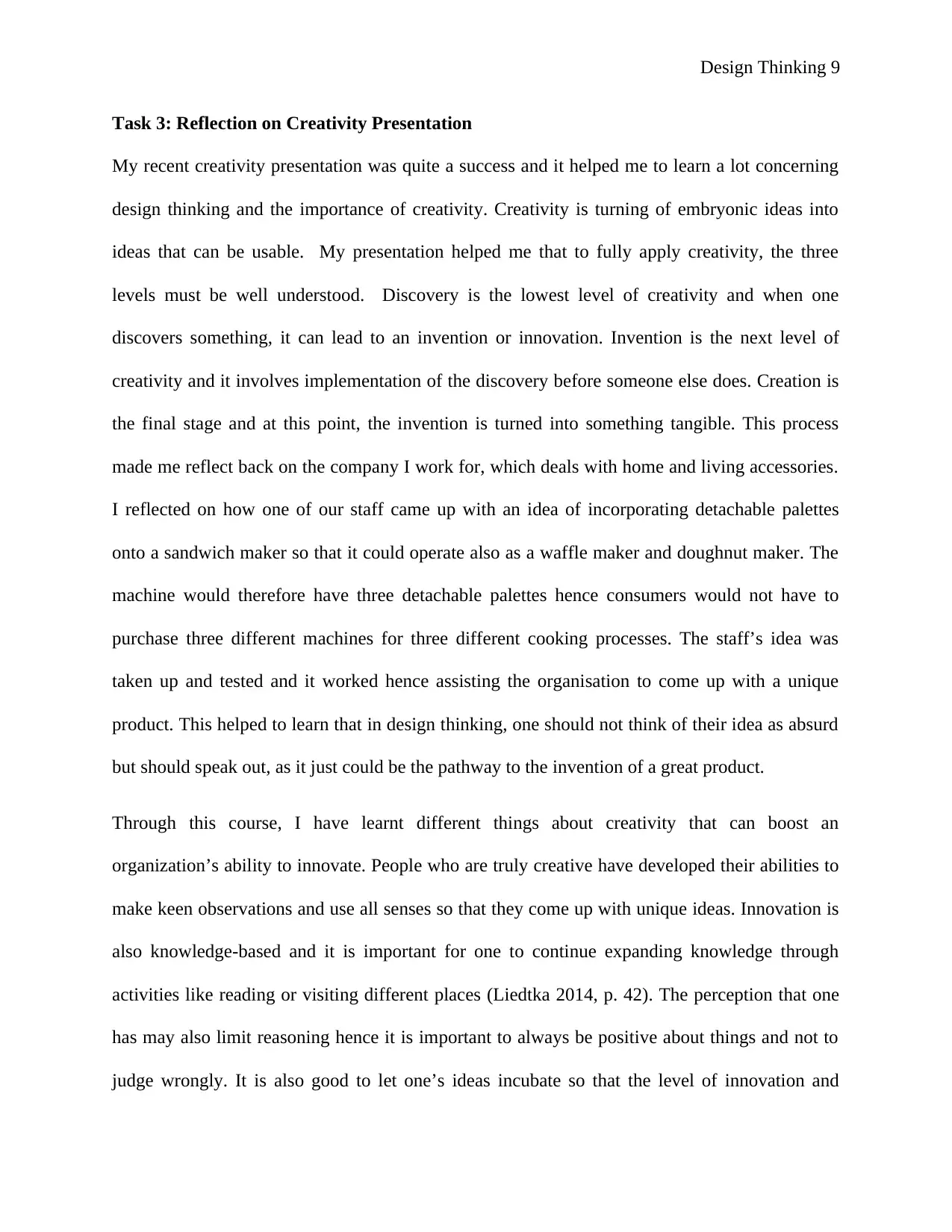
Design Thinking 9
Task 3: Reflection on Creativity Presentation
My recent creativity presentation was quite a success and it helped me to learn a lot concerning
design thinking and the importance of creativity. Creativity is turning of embryonic ideas into
ideas that can be usable. My presentation helped me that to fully apply creativity, the three
levels must be well understood. Discovery is the lowest level of creativity and when one
discovers something, it can lead to an invention or innovation. Invention is the next level of
creativity and it involves implementation of the discovery before someone else does. Creation is
the final stage and at this point, the invention is turned into something tangible. This process
made me reflect back on the company I work for, which deals with home and living accessories.
I reflected on how one of our staff came up with an idea of incorporating detachable palettes
onto a sandwich maker so that it could operate also as a waffle maker and doughnut maker. The
machine would therefore have three detachable palettes hence consumers would not have to
purchase three different machines for three different cooking processes. The staff’s idea was
taken up and tested and it worked hence assisting the organisation to come up with a unique
product. This helped to learn that in design thinking, one should not think of their idea as absurd
but should speak out, as it just could be the pathway to the invention of a great product.
Through this course, I have learnt different things about creativity that can boost an
organization’s ability to innovate. People who are truly creative have developed their abilities to
make keen observations and use all senses so that they come up with unique ideas. Innovation is
also knowledge-based and it is important for one to continue expanding knowledge through
activities like reading or visiting different places (Liedtka 2014, p. 42). The perception that one
has may also limit reasoning hence it is important to always be positive about things and not to
judge wrongly. It is also good to let one’s ideas incubate so that the level of innovation and
Task 3: Reflection on Creativity Presentation
My recent creativity presentation was quite a success and it helped me to learn a lot concerning
design thinking and the importance of creativity. Creativity is turning of embryonic ideas into
ideas that can be usable. My presentation helped me that to fully apply creativity, the three
levels must be well understood. Discovery is the lowest level of creativity and when one
discovers something, it can lead to an invention or innovation. Invention is the next level of
creativity and it involves implementation of the discovery before someone else does. Creation is
the final stage and at this point, the invention is turned into something tangible. This process
made me reflect back on the company I work for, which deals with home and living accessories.
I reflected on how one of our staff came up with an idea of incorporating detachable palettes
onto a sandwich maker so that it could operate also as a waffle maker and doughnut maker. The
machine would therefore have three detachable palettes hence consumers would not have to
purchase three different machines for three different cooking processes. The staff’s idea was
taken up and tested and it worked hence assisting the organisation to come up with a unique
product. This helped to learn that in design thinking, one should not think of their idea as absurd
but should speak out, as it just could be the pathway to the invention of a great product.
Through this course, I have learnt different things about creativity that can boost an
organization’s ability to innovate. People who are truly creative have developed their abilities to
make keen observations and use all senses so that they come up with unique ideas. Innovation is
also knowledge-based and it is important for one to continue expanding knowledge through
activities like reading or visiting different places (Liedtka 2014, p. 42). The perception that one
has may also limit reasoning hence it is important to always be positive about things and not to
judge wrongly. It is also good to let one’s ideas incubate so that the level of innovation and
⊘ This is a preview!⊘
Do you want full access?
Subscribe today to unlock all pages.

Trusted by 1+ million students worldwide
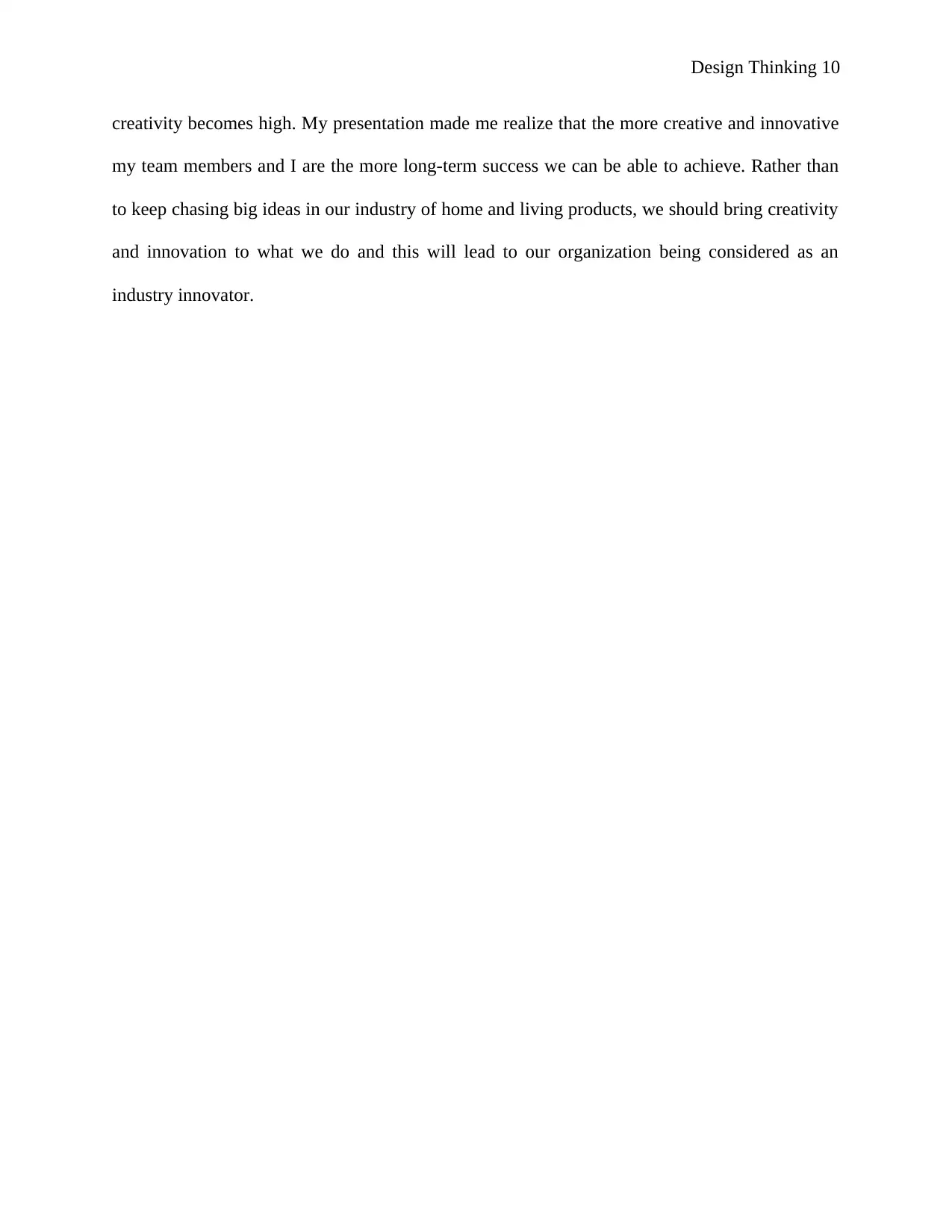
Design Thinking 10
creativity becomes high. My presentation made me realize that the more creative and innovative
my team members and I are the more long-term success we can be able to achieve. Rather than
to keep chasing big ideas in our industry of home and living products, we should bring creativity
and innovation to what we do and this will lead to our organization being considered as an
industry innovator.
creativity becomes high. My presentation made me realize that the more creative and innovative
my team members and I are the more long-term success we can be able to achieve. Rather than
to keep chasing big ideas in our industry of home and living products, we should bring creativity
and innovation to what we do and this will lead to our organization being considered as an
industry innovator.
Paraphrase This Document
Need a fresh take? Get an instant paraphrase of this document with our AI Paraphraser
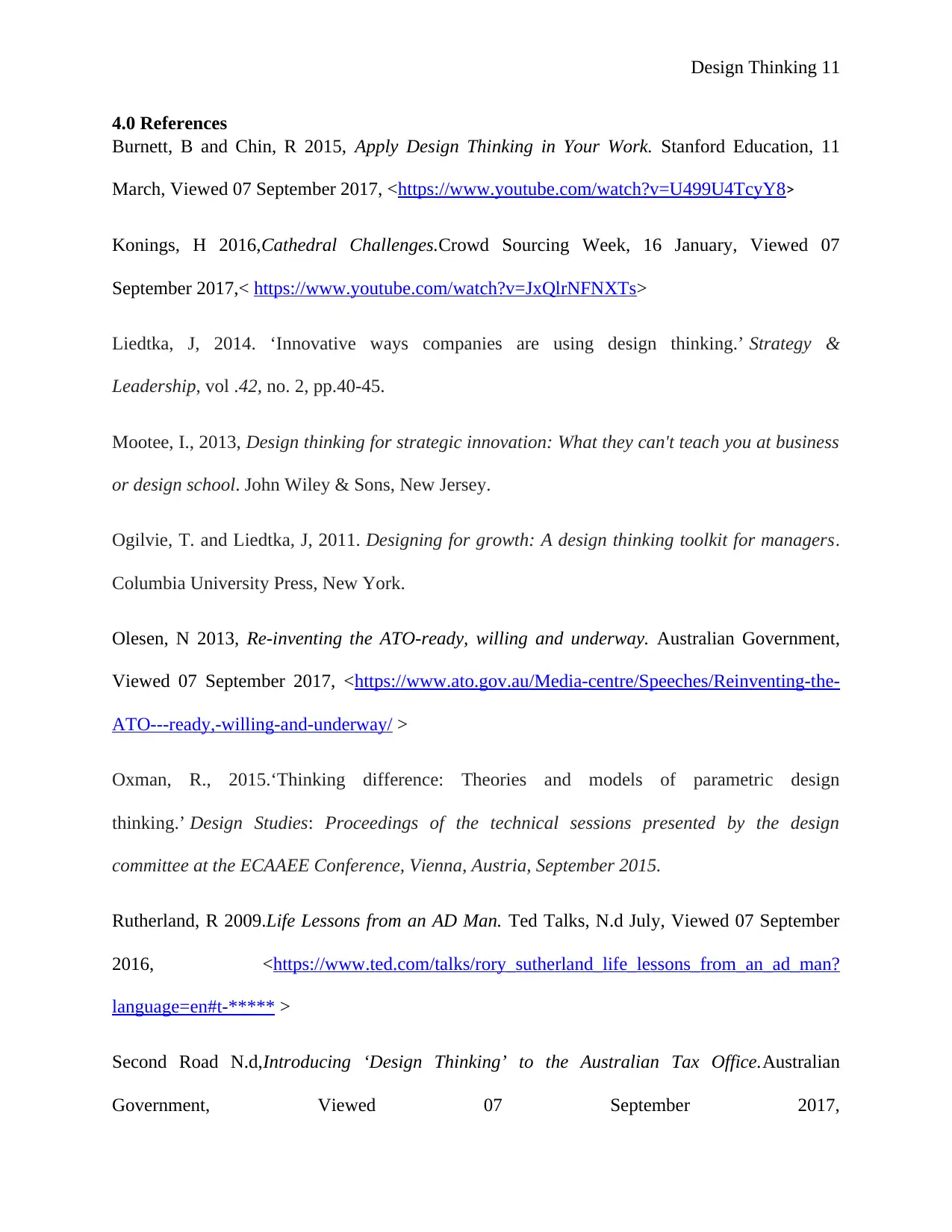
Design Thinking 11
4.0 References
Burnett, B and Chin, R 2015, Apply Design Thinking in Your Work. Stanford Education, 11
March, Viewed 07 September 2017, <https://www.youtube.com/watch?v=U499U4TcyY8>
Konings, H 2016,Cathedral Challenges.Crowd Sourcing Week, 16 January, Viewed 07
September 2017,< https://www.youtube.com/watch?v=JxQlrNFNXTs>
Liedtka, J, 2014. ‘Innovative ways companies are using design thinking.’ Strategy &
Leadership, vol .42, no. 2, pp.40-45.
Mootee, I., 2013, Design thinking for strategic innovation: What they can't teach you at business
or design school. John Wiley & Sons, New Jersey.
Ogilvie, T. and Liedtka, J, 2011. Designing for growth: A design thinking toolkit for managers.
Columbia University Press, New York.
Olesen, N 2013, Re-inventing the ATO-ready, willing and underway. Australian Government,
Viewed 07 September 2017, <https://www.ato.gov.au/Media-centre/Speeches/Reinventing-the-
ATO---ready,-willing-and-underway/ >
Oxman, R., 2015.‘Thinking difference: Theories and models of parametric design
thinking.’ Design Studies: Proceedings of the technical sessions presented by the design
committee at the ECAAEE Conference, Vienna, Austria, September 2015.
Rutherland, R 2009.Life Lessons from an AD Man. Ted Talks, N.d July, Viewed 07 September
2016, <https://www.ted.com/talks/rory_sutherland_life_lessons_from_an_ad_man?
language=en#t-***** >
Second Road N.d,Introducing ‘Design Thinking’ to the Australian Tax Office.Australian
Government, Viewed 07 September 2017,
4.0 References
Burnett, B and Chin, R 2015, Apply Design Thinking in Your Work. Stanford Education, 11
March, Viewed 07 September 2017, <https://www.youtube.com/watch?v=U499U4TcyY8>
Konings, H 2016,Cathedral Challenges.Crowd Sourcing Week, 16 January, Viewed 07
September 2017,< https://www.youtube.com/watch?v=JxQlrNFNXTs>
Liedtka, J, 2014. ‘Innovative ways companies are using design thinking.’ Strategy &
Leadership, vol .42, no. 2, pp.40-45.
Mootee, I., 2013, Design thinking for strategic innovation: What they can't teach you at business
or design school. John Wiley & Sons, New Jersey.
Ogilvie, T. and Liedtka, J, 2011. Designing for growth: A design thinking toolkit for managers.
Columbia University Press, New York.
Olesen, N 2013, Re-inventing the ATO-ready, willing and underway. Australian Government,
Viewed 07 September 2017, <https://www.ato.gov.au/Media-centre/Speeches/Reinventing-the-
ATO---ready,-willing-and-underway/ >
Oxman, R., 2015.‘Thinking difference: Theories and models of parametric design
thinking.’ Design Studies: Proceedings of the technical sessions presented by the design
committee at the ECAAEE Conference, Vienna, Austria, September 2015.
Rutherland, R 2009.Life Lessons from an AD Man. Ted Talks, N.d July, Viewed 07 September
2016, <https://www.ted.com/talks/rory_sutherland_life_lessons_from_an_ad_man?
language=en#t-***** >
Second Road N.d,Introducing ‘Design Thinking’ to the Australian Tax Office.Australian
Government, Viewed 07 September 2017,
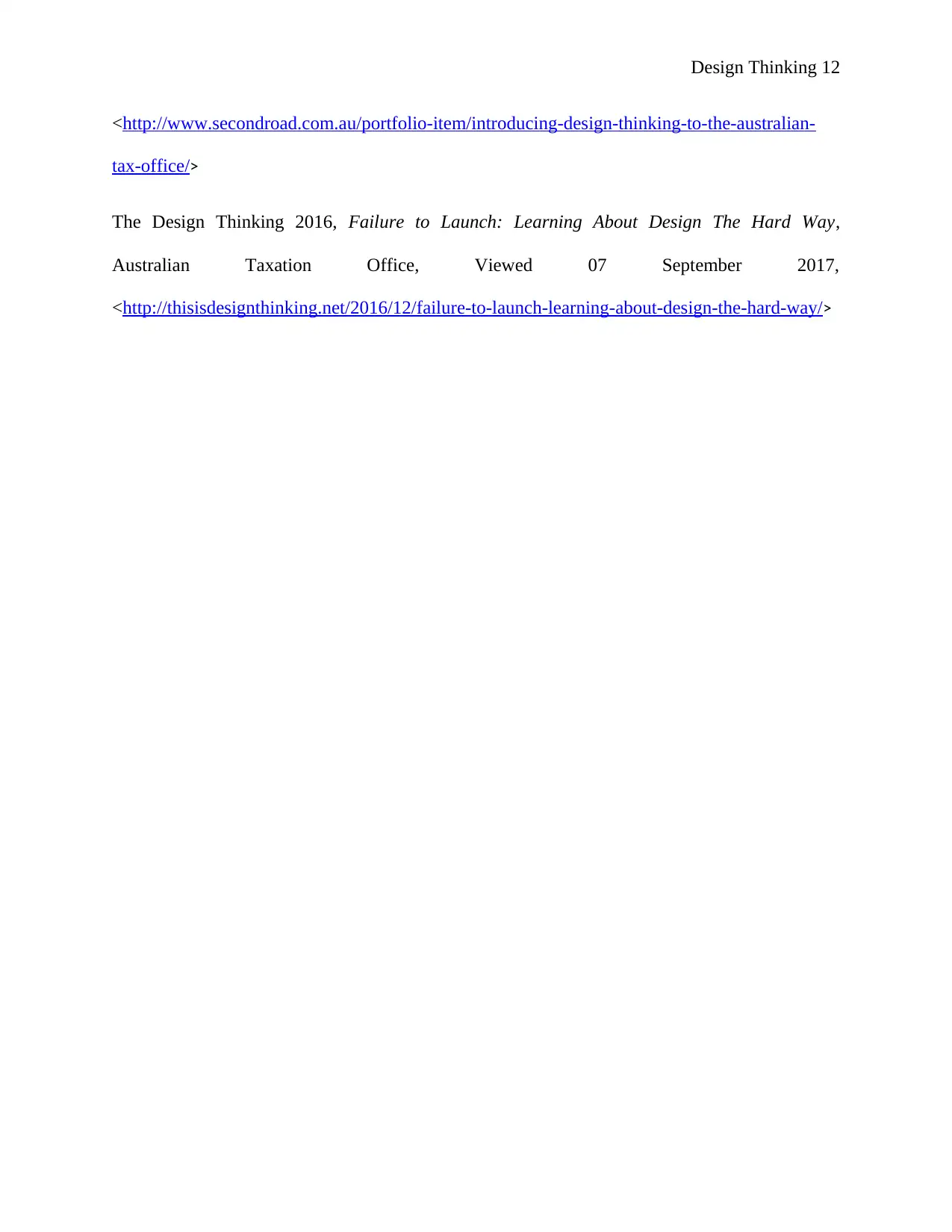
Design Thinking 12
<http://www.secondroad.com.au/portfolio-item/introducing-design-thinking-to-the-australian-
tax-office/>
The Design Thinking 2016, Failure to Launch: Learning About Design The Hard Way,
Australian Taxation Office, Viewed 07 September 2017,
<http://thisisdesignthinking.net/2016/12/failure-to-launch-learning-about-design-the-hard-way/>
<http://www.secondroad.com.au/portfolio-item/introducing-design-thinking-to-the-australian-
tax-office/>
The Design Thinking 2016, Failure to Launch: Learning About Design The Hard Way,
Australian Taxation Office, Viewed 07 September 2017,
<http://thisisdesignthinking.net/2016/12/failure-to-launch-learning-about-design-the-hard-way/>
⊘ This is a preview!⊘
Do you want full access?
Subscribe today to unlock all pages.

Trusted by 1+ million students worldwide
1 out of 12
Related Documents
Your All-in-One AI-Powered Toolkit for Academic Success.
+13062052269
info@desklib.com
Available 24*7 on WhatsApp / Email
![[object Object]](/_next/static/media/star-bottom.7253800d.svg)
Unlock your academic potential
Copyright © 2020–2025 A2Z Services. All Rights Reserved. Developed and managed by ZUCOL.





